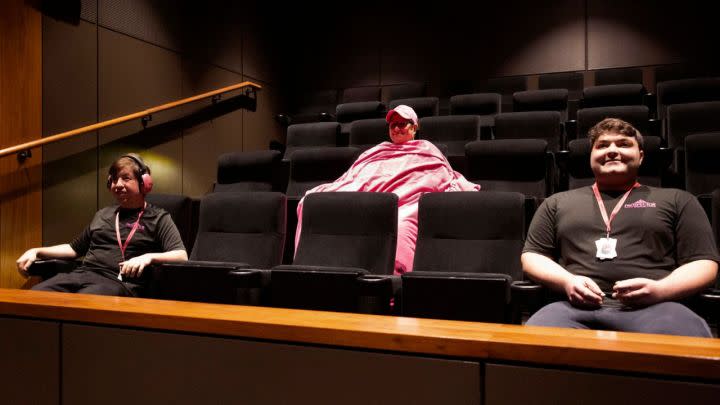They say nothing beats the moviegoing experience. Indeed, if the movie is good and the mood is set, there’s nothing better than sitting down with a good drink and tasty snacks to witness a great picture. Some theaters take things to the next level with gargantuan IMAX screens, intense and enveloping surround systems, and even seats that move, shake, and spray you. The theater experience can greatly enhance a movie, especially if there’s a large crowd around. I remember watching Avengers: Endgameopening weekend in a packed theater and hollering when Cap picked up Mjolnir.
There’s a sense of community that forms in these screenings when people with the same interests meet to celebrate. Even if you never talk to the person next to you — why would you? — everyone is still part of the experience. But what about those who can’t enjoy the same way you do? Some people don’t get a thrill out of cranking up every sensory input, especially if they are neurodivergent, and thus more aware and vulnerable to loud or extreme sounds, images, and lights. And while society is becoming more empathetic to neurodivergent people, there’s still a long way to go to adopt a truly inclusive approach.
Neurodivergent people face challenges neurotypical people can’t even begin to understand. Take the example I just gave: a packed movie theater with loud sounds, flashing lights, and a crowd yelling in excitement. A neurotypical individual might enjoy it, but it could be torture for a neurodivergent person, and it’s a shame because there’s no reason why they shouldn’t enjoy a movie. For years, the entertainment industry remained foreign to the struggles neurodivergent individuals face. However, as we become more aware and informed, steps are being taken to ensure a more inclusive landscape where all types of people can enjoy a movie. Enter sensory-friendly screenings, a project that is slowly but surely becoming more popular in movie theaters.
What is a sensory-friendly screening?
Sensory-friendly screenings are specially catered to those with sensory sensitivities, including but not limited to people on the autism spectrum. According to the Centers for Disease Control and Prevention, as of 2023, 1 in 36 children in the U.S. has autism, meaning it’s more important than ever to not only educate ourselves but take an active role in modifying our current practices so they can be more inclusive and, more importantly, more welcoming. Enter sensory-friendly screenings.
What’s different about these screenings is the presentation: The lights are turned on, the sound is turned down, and there are no trailers or advertisem*nts. This approach creates a more accessible environment where toddlers, children, and people with autism can enjoy a movie in a stress-free environment. Socializing is encouraged, as is singing, talking, standing up, and even using one’s phone, all of which allow these audiences to enjoy the film on their terms. The result is a new community meant to be easier, less strict, and more fluid. There are fewer rules, leading to a place where neurodivergent individuals can find solace from the often stressful outside world, all while enjoying a movie.
Commenting on the necessity of sensory-friendly screenings, Jacqueline Paige Grand Pré of the Jacob Burns Film Center tells me, “It’s clear that traditional movie screenings can be challenging for those with sensory sensitivities due to loud sounds, flashing lights, and being in an unfamiliar environment.” Pré is right; according to SPARK, an autism research study and growing community for autistic individuals, “At one point in their lives, 50 to 70 percent of autistic people were hypersensitive to everyday sounds.”
Ryan Wenke, executive director of The Prospector Theater in Connecticut, adds, “We do everything we can to make the entire experience sensory-friendly. Our Ushers will not use microphones to introduce the movies, we will not schedule other events (or) showtimes during it, and we allocate Quiet Spaces where guests can go if they are becoming overstimulated or need a break.” Modern life can be stressful and overwhelming even for neurotypical people, and the challenges that neurodivergent individuals face are increasing. Is it so hard to go the extra length to ensure their experience is less intense?
How does tech enhance sensory-friendly screenings?
Dimensions autism friendly screenings - Meet Lauren
At first sight, it might seem like tech plays little to no role in a sensory-friendly screening. As Cassie Nichols from AMC Theatres explains, “Two manual changes to the in-theatre environment are made — the house lights are kept at trailer level, and the sound is adjusted to the individual theatre crowd’s liking.” Pré adds, “(The) theater staff and projectionists tested a variety of A/V settings to determine what works best for the space.”
When it comes to these screenings, what works for one works for all. Thus, these default settings are repeated with each screening, remaining consistent with each showing — for the most part, at least. The lights are the same every time, but the sound changes since it depends on each film’s sound mixing.
“Our projectionists run tech screenings, which is basically a dry run ahead of the actual screening, to determine the base volume level for a given film and adjust the audio levels accordingly for sensory-friendly screenings,” Pré says. Audiences sure appreciate these measures, as the familiarity of the surroundings might make the whole experience less daunting, prompting them to return for future showings.
However, this is just a starting point for sensory-friendly screenings. What we’re seeing is each theater adopting a unique approach to their showings, and some are already ahead of the curve. For example, The Prospector Theater goes the extra mile. A nonprofit dedicated to providing competitive and inclusive employment to people with disabilities, The Prospector is truly revolutionizing the way movies are offered and consumed. Being more specialized than other theaters, The Prospector has two crucial tools available that can greatly enhance the experience.
TheraSpecs Glasses for Migraines, Light Sensitivity and Post-Concussion Syndrome
Strobe-canceling glasses are offered upon request, an aid that should become more prominent in movie theaters around the world. Tinted glasses, like those from TheraSpecs, protect the part of the brain that reacts to visual stimuli like harsh lights, thus shielding the wearer from damage, overstimulation, and even seizures. As previously mentioned, the lights at these screenings are modulated to accommodate for a less intense viewing experience. However, strobe-canceling glasses offer an additional layer of protection for those who need it, further personalizing their theater experience.
The Prospector also offers noise-canceling headphones upon request. Sound is important to a film, but it’s not vital, and offering noise-canceling headphones can allow certain neurodivergent individuals to appreciate a film’s visuals while avoiding the loud noises that often come with it. Alas, wearing them exhibits another weak point in the movie theater experience, and that is the lack of accessibility of close captions for those who are hard of hearing. Fortunately, some progress is also being made on this front.
For example, some theaters already offer closed-caption glasses, which, as their name implies, provide captions in real-time. They work through an algorithm, following the screenplay and synchronizing it to sounds and in-theater lights. The modulated sound and lights at sensory-friendly screenings do not interfere with these tech marvels, meaning they can be a perfect tool when paired with noise-canceling headphones. We’re talking about offering a truly personalized and almost revolutionary experience to those who might’ve not been able to fully enjoy a movie until now. When it comes to opening doors and making art more accessible, it can’t get any better than this.
How can tech keep improving sensory-friendly screenings?
Closed Caption Device at Cinemark Theaters
If the purpose is to create a more inclusive environment, there are still many steps we can take to make sensory-friendly screenings ever friendlier. After all, although great steps are already being taken to make sensory-friendly screenings more common and widely available, the project is still in its infancy. Not that this is a complaint; on the contrary, it’s a wonderful starting point and, even better, a promise that things can indeed keep getting better.
Takeclosed-caption stands, for example. These curious yet still rare tech innovations consist of a flexible pole attached to a small screen meant to fit into the cup holder. Some can find them irksome, as they essentially take the spot meant to hold a drink. However, neurodivergent people could greatly benefit from them, as having a small screen to manipulate could act akin to fidget tools while allowing them to enjoy the movie. Closed-caption stands could be a great tool if only they were more common in movie theaters and easier to use. Alas, they are still rare and subject to malfunctioning, especially if patrons don’t take proper care of them. They can also be hard to manipulate, adding an element of discomfort to the experience.
Accessibility should extend beyond the actual screening and into websites and ticketing. Social interactions can be difficult for neurodivergent people, and providing tools like screen reader accessibility and a less daunting, simplified version of a website can do wonders for navigation. As the name implies, screen readers are available for Mac, Windows, iOS, etc., and will translate text information into speech, with the user controlling it through a keyboard. Meanwhile, leaner, more streamlined versions of a theater’s webpage can make all the difference for an easily overwhelmed individual who might not appreciate a trailer popping out every two seconds.
The film experience begins hours, and sometimes days, before actually sitting in the movie theater, which is something not many theaters seem to remember. Adapting the whole journey, from purchase to viewing, is paramount for a more welcoming and attainable cinematic experience.
Who offers sensory-friendly screenings?
As previously mentioned, many theaters already offer sensory-friendly screenings. AMC, Harkins, Regal, and the Jacob Burns Film Center are among the many theaters offering this wonderful initiative. Unlike what some might think, they’re not rare or reserved for special occasions, even if they’re still not as widely available as regular showings. “The demand is just like every other title we play — the more popular titles perform better,” Cassie Nichols from AMC tells me.
More theaters can adopt these screenings. Associations like Dimensions in the U.K. offer training videos on how to offer sensory-friendly screenings. The training is easy to follow and helps remove some of the stigma surrounding these showings. After all, the ultimate purpose of art is to open doors, break down barriers, and amplify voices. A great movie entertains, thrills, and even dazzles. However, the best movies reveal something about human nature itself; they expose us to new experiences and points of view, connecting us with people and ideas we might not be able to reach otherwise.
For too long, this rich, often life-changing experience has been closed to neurodivergent people. At the very center of art must always lie empathy, the desire to connect and reach out. Sensory-friendly screenings and the technology and human element that powers them are a great way to allow art to do what it does best — what it should do, really: proliferate, expand, and flow. Because art should be for everyone, from great movies like Oppenheimerto the latest Zack Snyder CGI slugfest like Rebel Moon. Everyone should be able to watch a movie; it’s up to them if they like it or not.


